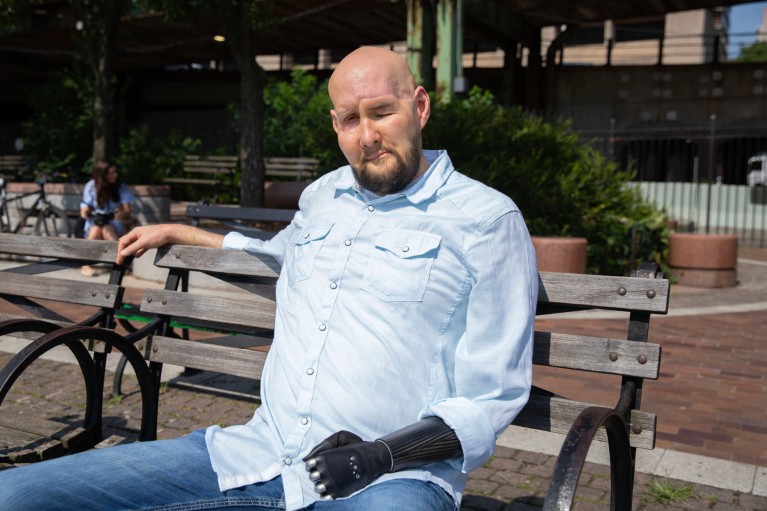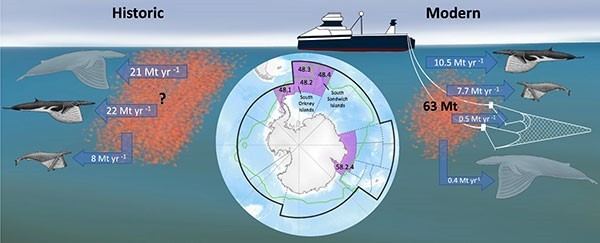Hello Nature readers, would you like to get this Briefing in your inbox free every day? Sign up here.

Aaron James now has one blue eye and one brown — the former his own, the latter from an unprecedented whole-eye transplant.Credit: Haley Ricciardi/NYU Langone Health
Aaron James, an electrical lineman who lost an eye and much of his face to an electrical accident, is the first person to receive a face transplant that includes a whole eye. The operation involved several innovative techniques, including 3D-printed guides that helped surgeons fit the donor’s bone to James’s face and a transplanted piece of carotid artery that provides the donated eye with its own blood supply. The eye responds to light, although researchers don’t believe it will connect to James’s brain well enough to restore his sight. “100/10, made medical history,” James’s daughter posted on TikTok. “Still bald headed, tho.”
Nature | 5 min read
Reference: JAMA paper
Growing immature eggs from old mice in the ovarian structures of young mice can reverse signs of ageing in the eggs. “Think of this as a five-star anti-ageing spa for the old egg,” says cell biologist and study co-author Rong Li. When the rejuvenated eggs were fertilized, the resulting embryos were almost four times more likely to give rise to healthy pups than the eggs that matured in the old environment. If the findings translate to people, they could lead to cell therapies that address infertility.
Nature | 4 min read
Reference: Nature Ageing paper
The United States and China are close to renewing a pact that governs their cooperation in science and technology, despite missing the deadline for doing so. The pact is symbolic, but researchers from both countries agree that it’s crucial for building strong collaborations. Nature’s sources say that while signs point to a renewal, the pact is likely to be more limited in scope and the upcoming US election could be factoring into the delay.
Nature | 5 min read
Marmosets use specific vocal labels to address other individual members of their species. When researchers separated pairs of marmosets with a barrier, they found that they used distinct ‘phee calls’ for the monkey on the other side. Besides humans, only dolphins and elephants have been recorded using similar labels for their fellow animals. “We think that this behaviour is important for [marmosets’] social cohesion and therefore it’s crucial for their survival,” says neuroscientist and co-author David Omer.
The Guardian | 4 min read
Reference: Science paper
Features & opinion
Table of Contents
The UK’s Research Excellence Framework (REF) is one of the most intensive systems of academic evaluation in any country. The seven-yearly assessment ranks research submissions from one star, less significant work of only national interest, to four star, world-leading research, and directly affects the distribution of around £2 billion every year. Other countries have put similar assessments in place, but critics say that such systems are having a detrimental effect on staff and, in some cases, are damaging researchers’ mental health. “Everyone’s constantly thinking of research in terms of ‘REF-able’ outputs, in terms of ‘REF-able’ impact,” says sociologist Richard Watermeyer. “Its influence is ubiquitous — you can’t escape it.”
Nature | 13 min read
In her new book Invisible Rulers, misinformation researcher Renée DiResta documents her stormy personal and professional journey into what she describes as the “fantasy–industrial complex”. The book’s title refers to online influencers who farm falsehoods for likes — their approach, as DiResta puts it, is “if you make it trend, you make it true”. Social psychologist Sander van der Linden, who has had his own experience being caught up as the target of Internet conspiracy-peddlers, lauds the book’s “nuanced discussion on the role of free speech, content moderation and education in our fractured media landscape”.
Nature | 8 min read
A rich vein of scientific and mathematical achievement runs through Indian history — but little of it is taught by the country’s education system, which retains the strong influence of British colonialism, reports Science. New education policies aim to decolonize the curriculum, with a requirement that at least 5% of higher-education credits come from courses that teach traditional Indian knowledge. The policies have proven controversial, with some academics arguing that they don’t reflect the variety of India’s multiethnic society. “I worry a formal syllabus will be contaminated by hypernationalism and false claims,” says Mayank Vahia, a former astronomy professor at the Tata Institute of Fundamental Research.
Science | 14 min read
Infographic of the week

Before whaling, a huge amount of krill supported the prey demands of approximately 180,000 blue (top left), fin, and humpback (bottom left) whales in the purple-shaded regions of the map. Now, a reduced krill population must support recovering numbers of whales and an expanding krill fishery. In these areas, krill fishers are catching more of the tiny creatures each year than the estimated needs of the entire blue whale population. (Reference: Nature Communications paper — see a larger version of the infographic here) (Matthew S. Savoca et al/Nature Communications)
Today I’m double-checking my house for priceless objects after learning that one of the largest pieces of ancient amber ever found spent decades being used as a doorstop. The 3.5-kilogram lovely lump, estimated to be between 38 and 70 million years old (and worth around €1 million), was originally discovered in a stream bed in Romania.
While I venture out to the Thames to search for treasure, why not send me your feedback on this newsletter? Your e-mails are always welcome at briefing@nature.com.
Thanks for reading,
Flora Graham, senior editor, Nature Briefing
With contributions by Jacob Smith, Sara Reardon and Smriti Mallapaty
Want more? Sign up to our other free Nature Briefing newsletters:
• Nature Briefing: Microbiology — the most abundant living entities on our planet — microorganisms — and the role they play in health, the environment and food systems.
• Nature Briefing: Anthropocene — climate change, biodiversity, sustainability and geoengineering
• Nature Briefing: AI & Robotics — 100% written by humans, of course
• Nature Briefing: Cancer — a weekly newsletter written with cancer researchers in mind
• Nature Briefing: Translational Research — covers biotechnology, drug discovery and pharma
